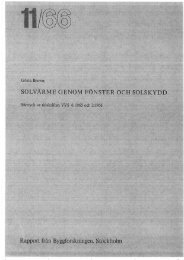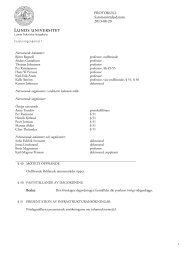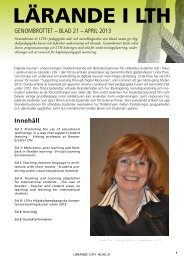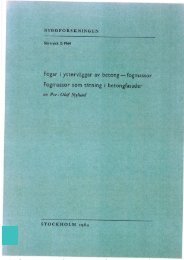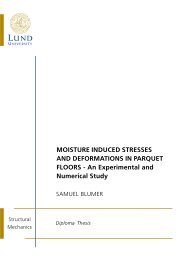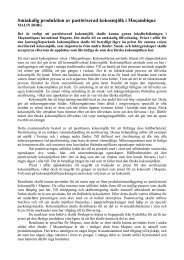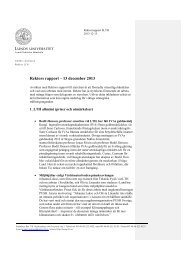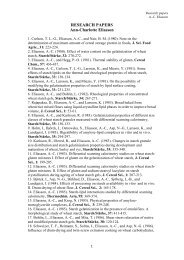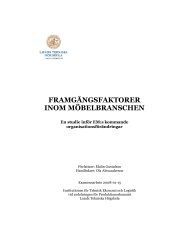User Experience Design at Sony Ericsson - Introducing the Virtual Pet
User Experience Design at Sony Ericsson - Introducing the Virtual Pet
User Experience Design at Sony Ericsson - Introducing the Virtual Pet
Create successful ePaper yourself
Turn your PDF publications into a flip-book with our unique Google optimized e-Paper software.
5.4 Goal and Task Definition<br />
Moving on in <strong>the</strong> design process, <strong>the</strong> next two phases are goal- and task definition.<br />
Goals are <strong>the</strong> reason why we perform tasks. Analyzing goals is done in order to identify <strong>the</strong> user’s goals behind <strong>the</strong> use of a<br />
certain design, be it <strong>the</strong> entire mobile phone, an applic<strong>at</strong>ion, or a single function within <strong>the</strong> applic<strong>at</strong>ion. When a user is<br />
using an applic<strong>at</strong>ion, e.g. <strong>the</strong> phonebook, she has an underlying goal th<strong>at</strong> she wants to achieve. The design should be goal<br />
directed - not only task directed. It is <strong>the</strong>refore important to look <strong>at</strong> <strong>the</strong> underlying goals of <strong>the</strong> user. Your design should help<br />
<strong>the</strong> user to achieve <strong>the</strong>se goals with minimum effort. Goals are constant in th<strong>at</strong> users do not care how <strong>the</strong>y achieve <strong>the</strong> goals,<br />
just th<strong>at</strong> <strong>the</strong> method or task is convenient, reliable, easy.<br />
From <strong>the</strong> <strong>Sony</strong> <strong>Ericsson</strong> user centered design process<br />
An analysis of users’ goals frequently renders several different goals. Some of <strong>the</strong>m are high-level goals th<strong>at</strong> are<br />
rel<strong>at</strong>ed to use qualities; o<strong>the</strong>rs are low-level goals th<strong>at</strong> liken fe<strong>at</strong>ure specific<strong>at</strong>ions. Not all goals are immedi<strong>at</strong>ely<br />
rel<strong>at</strong>ed to each o<strong>the</strong>r, but some goals are formed in a hierarchy th<strong>at</strong> can be understood by laddering. Laddering is<br />
a method with a history of use in marketing where it has been used to uncover users’ underlying wants and needs<br />
(Jordan 2000). An example of laddering is seen below, where <strong>the</strong> ability to change phone cover is linked to <strong>the</strong><br />
ability to express individuality.<br />
Example of laddering.<br />
In <strong>the</strong> current design process, it is assumed th<strong>at</strong> users have fairly well defined goals or sub-goals, and th<strong>at</strong> <strong>the</strong>y can<br />
reach <strong>the</strong>se by conducting multiple sub-tasks. If <strong>the</strong> user’s goal is – for example - to call a friend, this approach<br />
can be quite fruitful; rendering clear sub tasks th<strong>at</strong> can be approached with usability methods to make <strong>the</strong>m as<br />
easy and efficient as possible. The ease of goal definition is partly due to fairly well developed measurements for<br />
<strong>the</strong> three use qualities efficiency, effectiveness and user s<strong>at</strong>isfaction. Below is an example of how <strong>the</strong> three use<br />
qualities in usability are broken down to measurements.<br />
Use Quality Goal (abstract) Goal (concrete) Measurement<br />
Efficiency<br />
<strong>User</strong>s should be able to find<br />
a contact quickly<br />
A few steps should be<br />
enough to call a person<br />
Effectiveness <strong>User</strong>s should be able to find<br />
and call a person without<br />
mistakes<br />
<strong>User</strong><br />
S<strong>at</strong>isfaction<br />
<strong>User</strong>s should feel th<strong>at</strong> it is<br />
easy to make a phone call<br />
<strong>User</strong>s should be able to find a<br />
contact in less than 60 seconds.<br />
<strong>User</strong>s should be able to make a call<br />
in less than 4 steps.<br />
75% of users should be able to<br />
complete <strong>the</strong> task <strong>the</strong> first time <strong>the</strong>y<br />
try it.<br />
<strong>User</strong> should r<strong>at</strong>e ease of use 4-5 on<br />
a 1-5 scale<br />
Time<br />
Interaction<br />
steps<br />
Error r<strong>at</strong>e<br />
Likert scale<br />
In traditional usability, three use qualities are broken down to goals and measurements. Table adapted from Qvarfordt (20002).<br />
15



